Detailed Characterization of a Fully Additive Covalent Bonded PCB Manufacturing Process (SBU-CBM Method)
Abstract
:1. Introduction
- To demonstrate, in detail, the fabrication steps involved in a fully additive fabrication, i.e., SBU-CBM method.
- To show the surface modification mechanism and the metallization technique using different characterizations and complementary DFT.
- To combine the analysis from experimental and simulation results towards concretization of a production technique useful in printed electronics.
2. Experimental Methods
2.1. Materials and Sample Preparation
- Sample 1:
- Only FR-4.
- Sample 2:
- Polyurethane (PU) spin-coated on top of FR-4.
- Sample 3:
- Polymerized CBM solution (HP-14) seed layer on top of PU and FR-4 (sample with laser activation and without cleaning of the surface).
- Sample 4:
- After the predip bath immersion (Bath-1).
- Sample 5:
- After the activator bath immersion (Bath-2).
- Sample 6:
- After the reducer bath immersion (Bath-3).
- Sample 7:
- After the Cu bath immersion (Bath-4).
2.2. Chemical Constituents and Methodology
2.3. Characterization
3. Computational Methods
4. Results and Discussion
4.1. XRD Analysis
4.2. SEM-EDS Analysis
4.2.1. Laser Activation of CBM Seed Layer
4.2.2. Electroless Copper Plating
Catalytic Behavior of Pd Ion
Auto-Catalytic Copper Deposition
4.3. DFT Analysis
4.4. Process Parameters
5. Summary and Conclusions
Author Contributions
Funding
Institutional Review Board Statement
Informed Consent Statement
Data Availability Statement
Acknowledgments
Conflicts of Interest
References
- Kantola, V.; Kulovesi, J.; Lahti, L.; Lin, R.; Zavodchikova, M.; Coatanéa, E. 1.3 Printed electronics, now and future. Bit Bang 2009, 63, 204. [Google Scholar]
- Suganuma, K. Introduction to Printed Electronics; Springer: Berlin, Germany, 2014; Volume 74. [Google Scholar]
- Lee, S.J.; Rahman, A.M. Intelligent Packaging for Food Products; Elsevier: Amsterdam, The Netherlands, 2014; pp. 171–209. [Google Scholar]
- Khan, Y.; Thielens, A.; Muin, S.; Ting, J.; Baumbauer, C.; Arias, A.C. A new frontier of printed electronics: Flexible hybrid electronics. Adv. Mater. 2020, 32, 1905279. [Google Scholar]
- Cantatore, E. Applications of Organic and Printed Electronics. A Technology-Enabled Revolution; Springer: New York, NY, USA, 2013; p. 180. [Google Scholar]
- Izdebska, J. Applications of printed materials. In Printing on Polymers: Fundamentals and Applications; Elsevier: Amsterdam, The Netherlands, 2016; pp. 371–388. [Google Scholar]
- Cruz, S.M.F.; Rocha, L.A.; Viana, J.C. Printing technologies on flexible substrates for printed electronics. In Flexible Electronics; IntechOpen: London, UK, 2018; Available online: https://www.intechopen.com/books/6765 (accessed on 15 March 2022).
- Cui, Z. Printed Electronics: Materials, Technologies and Applications; John Wiley & Sons: Hoboken, NJ, USA, 2016. [Google Scholar]
- Wiklund, J.; Karakoç, A.; Palko, T.; Yiğitler, H.; Ruttik, K.; Jäntti, R.; Paltakari, J. A review on printed electronics: Fabrication methods, inks, substrates, applications and environmental impacts. J. Manuf. Mater. Process. 2021, 5, 89. [Google Scholar]
- Yang, C.Y.; Stoeckel, M.A.; Ruoko, T.P.; Wu, H.Y.; Liu, X.; Kolhe, N.B.; Wu, Z.; Puttisong, Y.; Musumeci, C.; Massetti, M.; et al. A high-conductivity n-type polymeric ink for printed electronics. Nat. Commun. 2021, 12, 1–8. [Google Scholar]
- Acharya, S.; Chouhan, S.S.; Delsing, J. An Additive Production approach for Microvias and Multilayered polymer substrate patterning of 2.5 μm feature sizes. In Proceedings of the 2020 IEEE 70th Electronic Components and Technology Conference (ECTC), Orlando, FL, USA, 3–30 June 2020; pp. 1304–1308. [Google Scholar]
- Acharya, S.; Chouhan, S.S.; Delsing, J. Scalability of Copper-Interconnects down to 3 μ m on Printed Boards by Laser-assisted-subtractive process. In Proceedings of the Additional Conferences (Device Packaging, HiTEC, HiTEN, & CICMT), International Microelectronics Assembly and Packaging Society, Copenhagen, Denmark, 10–13 June 2019; Volume 2019, pp. 17–20. [Google Scholar]
- Acharya, S.; Chouhan, S.S.; Delsing, J. Fabrication Process for On-Board Geometries Using a Polymer Composite-Based Selective Metallization for Next-Generation Electronics Packaging. Processes 2021, 9, 1634. [Google Scholar]
- Swenson, O.; Marinov, V. Laser processing of direct-write Nano-sized materials. In Advances in Laser Materials Processing; Elsevier: Amsterdam, The Netherlands, 2010; pp. 671–694. [Google Scholar]
- Ahn, J.; Sim, H.H.; Kim, J.H.; Wajahat, M.; Kim, J.H.; Bae, J.; Kim, S.; Pyo, J.; Jeon, C.J.; Kim, B.S.; et al. Air-Pressure-Assisted Pen-Nib Printing for 3D Printed Electronics. Adv. Mater. Technol. 2021, 2101172. [Google Scholar] [CrossRef]
- Watanabe, A.; Qin, G.; Cai, J. Laser Direct Writing on Copper Nanoparticle Film by LightScribe Technique. J. Photopolym. Sci. Technol. 2015, 28, 99–102. [Google Scholar]
- Lewis, J.A.; Ahn, B.Y. Three-dimensional printed electronics. Nature 2015, 518, 42–43. [Google Scholar]
- Parmar, H.; Tucci, F.; Carlone, P.; Sudarshan, T. Metallisation of polymers and polymer matrix composites by cold spray: State of the art and research perspectives. Int. Mater. Rev. 2021, 1–25. [Google Scholar] [CrossRef]
- Le Lesle, J.; Quemener, V.; Morrand, J.; Perrin, R.; Mrad, R.; Mollov, S. Design, Manufacturing and Evaluation of a Highly Integrated Low-Voltage High-Current Inverter. In Proceedings of the CIPS 2020: 11th International Conference on Integrated Power Electronics Systems, Berlin, Germany, 24–26 March 2020; pp. 1–5. [Google Scholar]
- Toh, H.W. Copper Metallisation for High-Density Interconnects and Planar Inductors. Ph.D. Thesis, Queen’s University of Belfast, Northern Ireland, UK, 2002. [Google Scholar]
- Wang, J. Electrodeposition and Characterisation of Nickel-Niobium-Based Diffusion Barrier Metallisations for High Temperature Electronics Interconnections. Ph.D. Thesis, Loughborough University, Loughborough, UK, 2016. [Google Scholar]
- Kerr, C.; Barker, D.; Walsh, F. Electroless deposition of metals. Trans. IMF 2001, 79, 41–46. [Google Scholar]
- Mavliev, R.; Gottfried, K.; Rhoades, R. Advanced Packaging Cost Reduction by Selective Copper Metallization. In Proceedings of the 2020 IEEE 70th Electronic Components and Technology Conference (ECTC), Orlando, FL, USA, 3–30 June 2020; pp. 327–332. [Google Scholar]
- Lennon, A.; Colwell, J.; Rodbell, K.P. Challenges facing copper-plated metallisation for silicon photovoltaics: Insights from integrated circuit technology development. Prog. Photovoltaics Res. Appl. 2019, 27, 67–97. [Google Scholar]
- Kordás, K.; Nánai, L.; Bali, K.; Stépán, K.; Vajtai, R.; George, T.F.; Leppävuori, S. Palladium thin film deposition from liquid precursors on polymers by projected excimer beams. Appl. Surf. Sci. 2000, 168, 66–70. [Google Scholar]
- Acharya, S.; Chouhan, S.S.; Delsing, J. Realization of Embedded Passives using an additive Covalent bonded metallization approach. In Proceedings of the 2019 22nd European Microelectronics and Packaging Conference & Exhibition (EMPC), Pisa, Italy, 16–19 September 2019; pp. 1–6. [Google Scholar]
- Atthoff, B.; Göthe, S. Cuptronics Technology; Cuptronic Technology: Stockholm, Sweden; Available online: http://cuptronic.com (accessed on 15 March 2022).
- Johan Lundqvist, F.V. J-KEM International. Available online: http://jkem.se (accessed on 15 March 2022).
- Atthoff, B.; Göthe, S. Metalization of Surfaces. U.S. Patent 10,822,702, 16 February 2017. [Google Scholar]
- Blöchl, P.E. Projector Augmented-Wave Method. Phys. Rev. B 1994, 50, 17953–17979. [Google Scholar] [CrossRef] [Green Version]
- Kresse, G.; Furthmüller, J. Efficient Iterative Schemes for Ab Initio Total-Energy Calculations Using a Plane-Wave Basis Set. Phys. Rev. B 1996, 54, 11169–11186. [Google Scholar] [CrossRef]
- Kresse, G.; Joubert, D. From Ultrasoft Pseudopotentials to the Projector Augmented-Wave Method. Phys. Rev. B 1999, 59, 1758–1775. [Google Scholar] [CrossRef]
- Perdew, J.P.; Burke, K.; Ernzerhof, M. Generalized Gradient Approximation Made Simple. Phys. Rev. Lett. 1996, 77, 3865. [Google Scholar] [CrossRef] [Green Version]
- Grimme, S.; Antony, J.; Ehrlich, S.; Krieg, H. A Consistent and Accurate Ab Initio Parametrization of Density Functional Dispersion Correction (DFT-D) For the 94 Elements H-Pu. J. Chem. Phys. 2010, 132, 154104. [Google Scholar] [CrossRef] [Green Version]
- Herath, U.; Tavadze, P.; He, X.; Bousquet, E.; Singh, S.; Muñoz, F.; Romero, A.H. PyProcar: A Python Library for Electronic Structure Pre/Post-Processing. Comput. Phys. Commun. 2020, 251, 107080. [Google Scholar] [CrossRef] [Green Version]
- Theivasanthi, T.; Alagar, M. X-ray diffraction studies of copper nanopowder. arXiv 2010, arXiv:1003.6068. [Google Scholar]
- Hsu, H.H.; Lin, K.H.; Lin, S.J.; Yeh, J.W. Electroless copper deposition for ultralarge-scale integration. J. Electrochem. Soc. 2001, 148, C47. [Google Scholar]
- Tracy, D.; Knorr, D.; Rodbell, K. Texture in multilayer metallization structures. J. Appl. Phys. 1994, 76, 2671–2680. [Google Scholar]
- Mittal, K.L. Metallized Plastics 5&6: Fundamental and Applied Aspects; VSP: Rancho Cordova, CA, USA, 1998. [Google Scholar]
- Ma, Z.; Tan, K.; Kang, E. Electroless plating of palladium and copper on polyaniline films. Synth. Met. 2000, 114, 17–25. [Google Scholar]
- Park, N.; Kim, I.W.; Kim, J. Copper metallization of poly (ethylene terephthalate) fabrics via intermediate polyaniline layers. Fibers Polym. 2009, 10, 310–314. [Google Scholar]
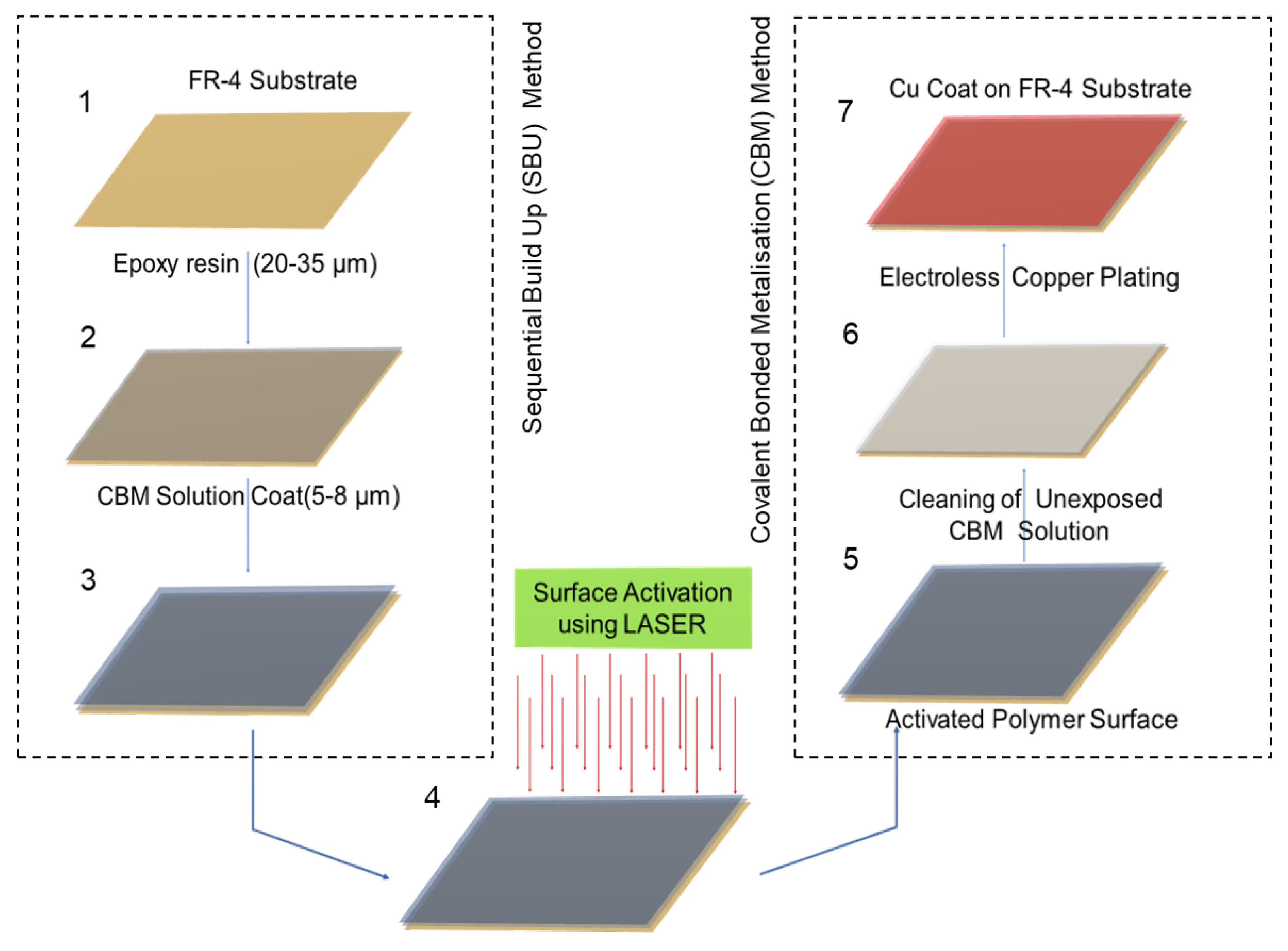
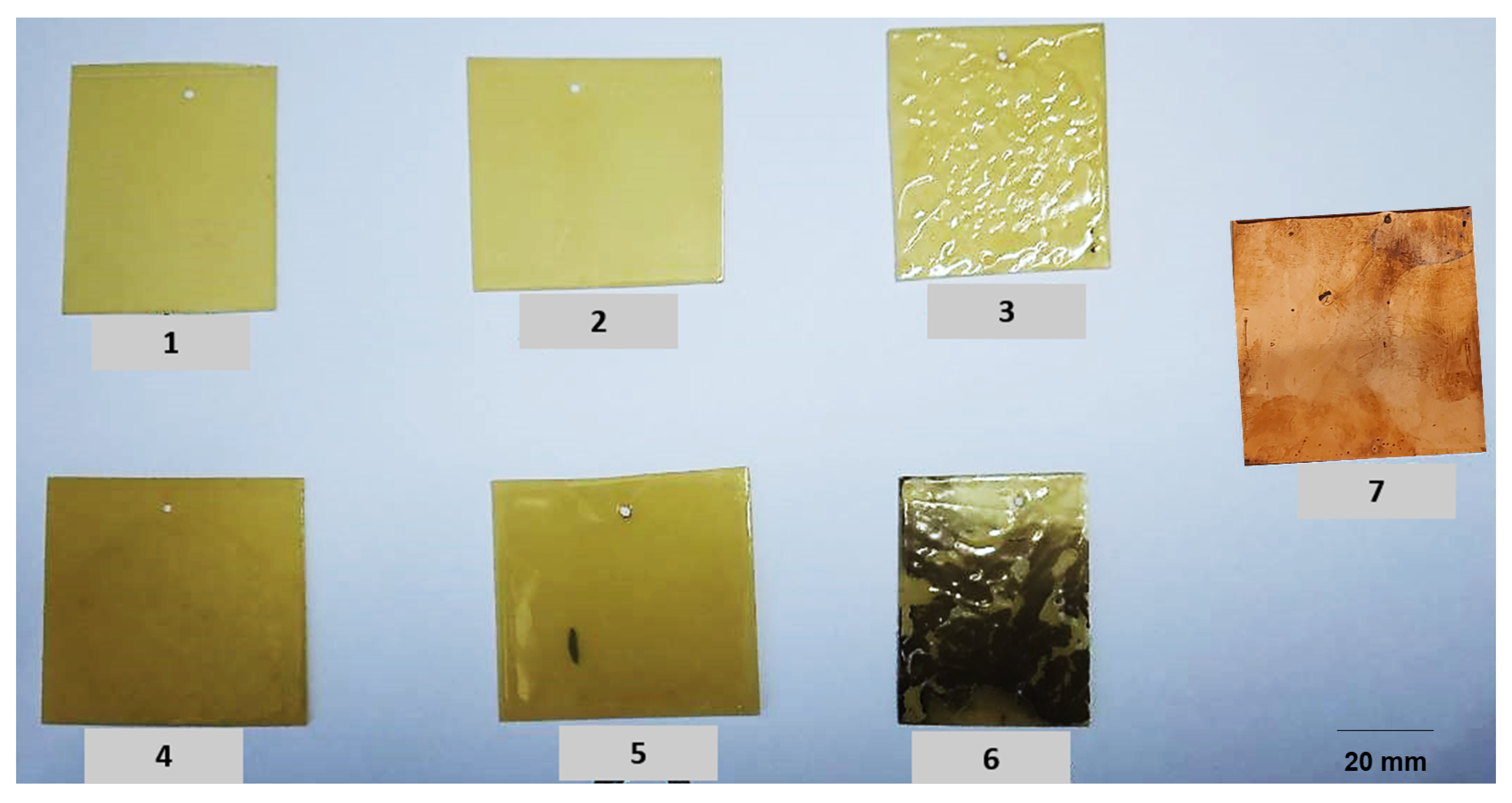
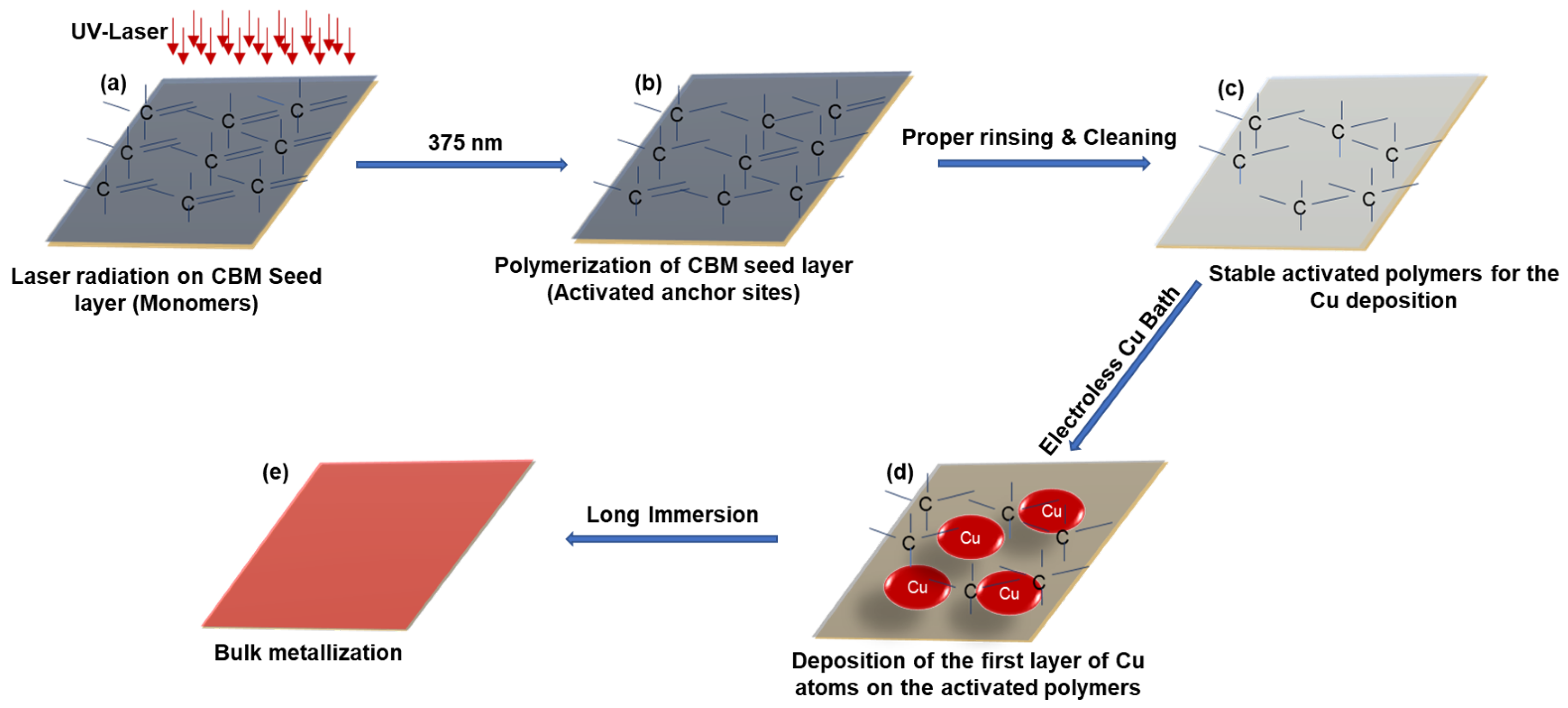


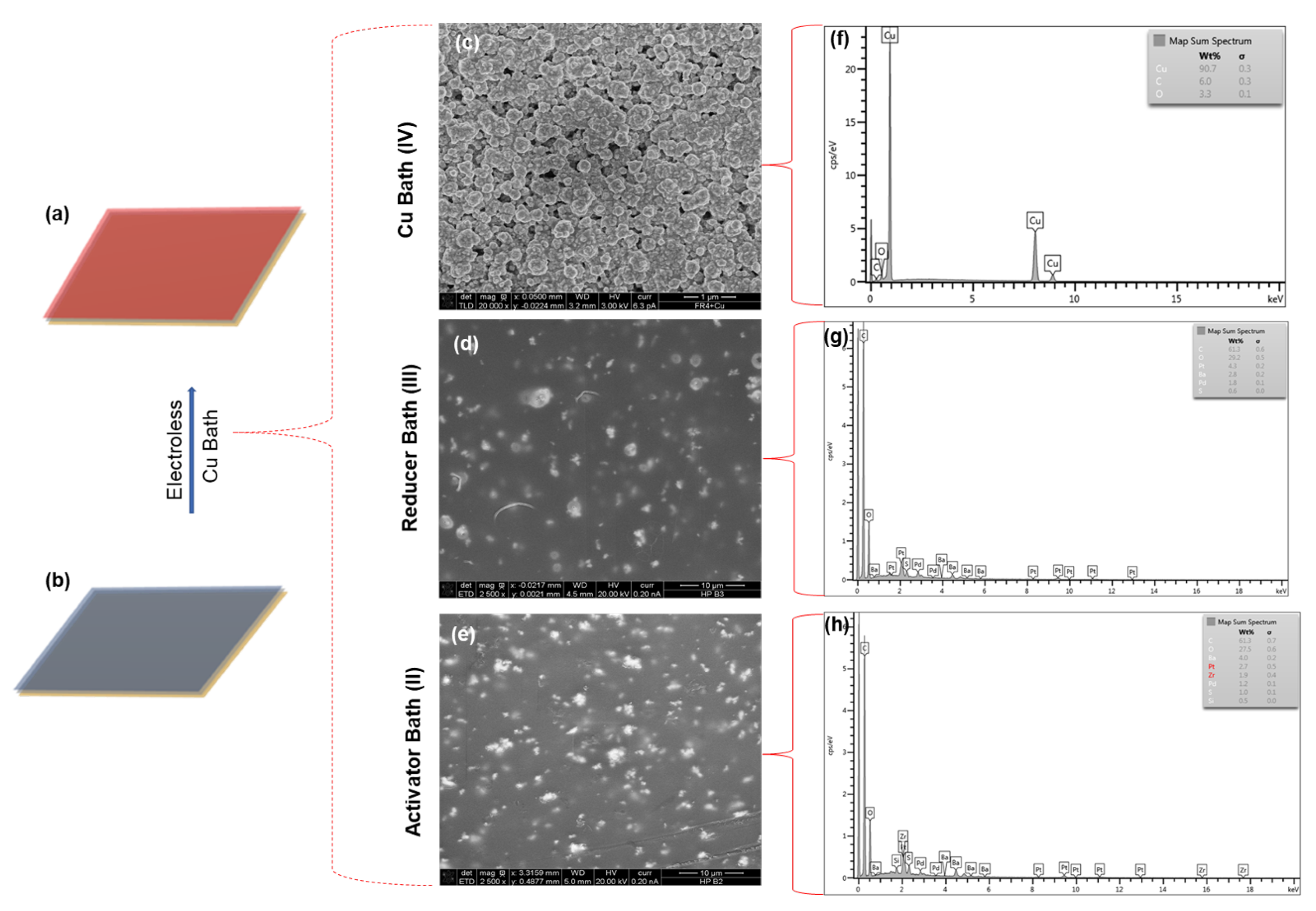
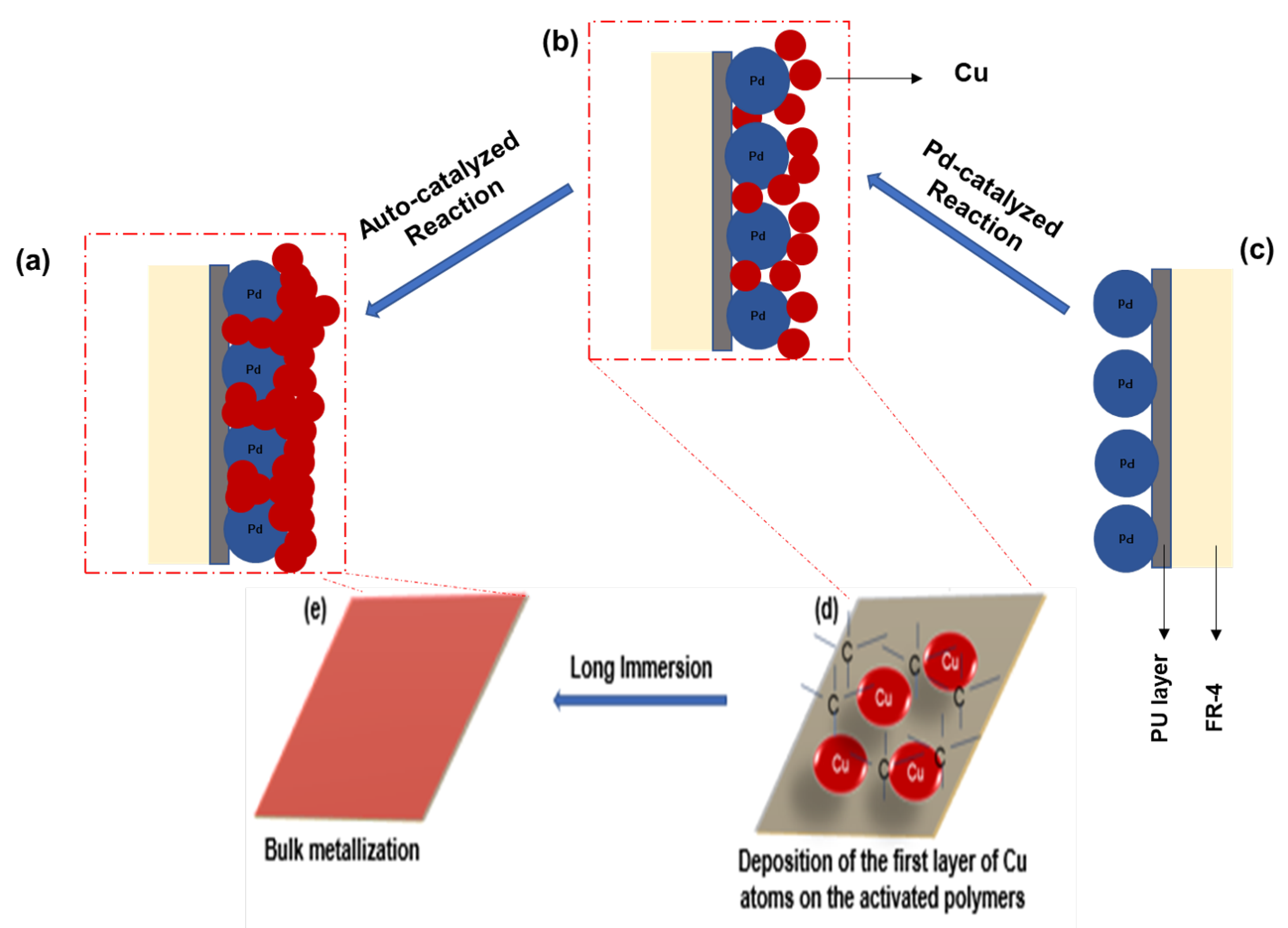

| Electroless Copper Bath Parameters | |||||
|---|---|---|---|---|---|
| Type | Name | Concentartion | Time (min) | Temperature (C) | |
| I | Predip | Precup-128 | 50 mL in 200 mL of DIW | 1 | 25 |
| II | Activator | Catcup-207 | 50 mL in 200 mL of DIW | 5 | 42 |
| III | Reducer | Boric acid + ACS-2075 | 2.2 gm in 100 mL of DIW + 1.1 mL of ACS-2075 | 5 | 25 |
| IV | Cu Bath | PEC-660 (A/M/B) | 9.50 mL of PEC-A + 6.75 mL of PEC-M + 9.50 mL of PEC-B in 100 mL of DIW | 3–5 | 25 |
Publisher’s Note: MDPI stays neutral with regard to jurisdictional claims in published maps and institutional affiliations. |
© 2022 by the authors. Licensee MDPI, Basel, Switzerland. This article is an open access article distributed under the terms and conditions of the Creative Commons Attribution (CC BY) license (https://creativecommons.org/licenses/by/4.0/).
Share and Cite
Acharya, S.; Sattar, S.; Chouhan, S.S.; Delsing, J. Detailed Characterization of a Fully Additive Covalent Bonded PCB Manufacturing Process (SBU-CBM Method). Processes 2022, 10, 636. https://doi.org/10.3390/pr10040636
Acharya S, Sattar S, Chouhan SS, Delsing J. Detailed Characterization of a Fully Additive Covalent Bonded PCB Manufacturing Process (SBU-CBM Method). Processes. 2022; 10(4):636. https://doi.org/10.3390/pr10040636
Chicago/Turabian StyleAcharya, Sarthak, Shahid Sattar, Shailesh Singh Chouhan, and Jerker Delsing. 2022. "Detailed Characterization of a Fully Additive Covalent Bonded PCB Manufacturing Process (SBU-CBM Method)" Processes 10, no. 4: 636. https://doi.org/10.3390/pr10040636
APA StyleAcharya, S., Sattar, S., Chouhan, S. S., & Delsing, J. (2022). Detailed Characterization of a Fully Additive Covalent Bonded PCB Manufacturing Process (SBU-CBM Method). Processes, 10(4), 636. https://doi.org/10.3390/pr10040636







